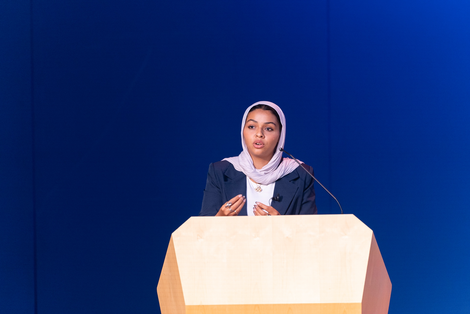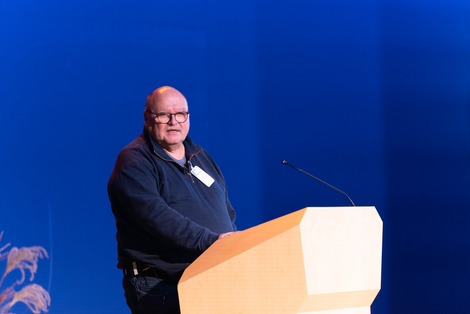Building a vibrant community in the desert – the Sekem Initiative
Helmy Abouleish and Buthaina Elhoseiny gave an impressive account of the Egyptian Sekem Initiative, which was founded in 1977 by Ibrahim Abouleish. A barren desert has been transformed into a thriving community: around 2,000 people now work in agriculture, textile factories, educational institutions, clinics, etc. The ‘Economy of Love’ project aims to enable around 40,000 small businesses in Egypt to transition to biodynamic agriculture by the end of 2026 – with better incomes, healthcare and long-term social security.
A milestone in Sekem's development is the co-founding of Heliopolis University in Cairo. Sekem shows that development is possible when education, ecology and community intertwine. For example, all employees can attend the same courses – people from different areas of work meet in painting classes, which strengthens cohesion.
Hazoua – date oasis in Tunisia
Another example of successful sustainable agriculture is Hazoua, a Tunisian oasis on the Algerian border. What once began on the initiative of Swiss Reto Ingold is now self-managed: the cultivation of biodynamic dates, which are exported to Switzerland. ‘The Hazoua initiative gives us young people the opportunity to stay in the countryside and thus counteract rural exodus – even though I personally sometimes long for the city,’ said date farmer Saidi Salah.
Agriculture in refugee camps
We heard deeply moving stories from Western Sahara. The conflict, which has been going on for almost 50 years and has forced the once nomadic Sahrawi people to live in refugee camps for decades, is hardly ever mentioned in our media.
Agronomist Taleb Brahim reported on how so-called ‘domes’ are being built in the Sahrawi refugee camps – facilities where vegetables are grown in the middle of the desert sand. But this is about much more than food production: here, farming means gaining self-determination and a piece of home.
Artist and human rights activist Asria Mohamed Taleb, who grew up in one of these camps herself, brought this idea to the Goetheanum with her art project ‘Jaimitna’ (‘our tent’). She set up a Jaimitna where visitors could drink tea and use QR codes to listen to the stories of the women who had made the fabrics inside the tent.
The question of responsibility
Alexander Batran from Weleda AG reported on rose cultivation in Morocco, which mainly provides work for women – supported by childcare and fair working structures. He emphasised the importance of transparent value chains in which producers and buyers are in direct contact and all those involved are fairly remunerated.
Agroforestry expert Roland Frutig used scientific findings to show how new greenery can be created even in desert regions without endangering sensitive groundwater reserves. His work in Africa, India and Egypt illustrates that when different farming systems learn from each other, sustainable agriculture can succeed even under extreme conditions.
At the same time, critical questions were not left out: Does greening threaten the water reserves beneath the Sahara? How can economic responsibility be reconciled with political reality, for example in the Western Sahara? And do changes in the microclimate affect the global climate? The theme day did not shy away from such challenges – it highlighted them and opened up space for exchange and mutual understanding.
A day that sparked hope
Djim Radé and his jazz band from Chad brought the day to a close. The impression was that, despite the seemingly hopeless situation – marked by climate change and ongoing conflicts such as in Western Sahara – there is hope: ‘Greening the Desert’ shows that the seemingly impossible can become possible – in agriculture as well as in social coexistence.







